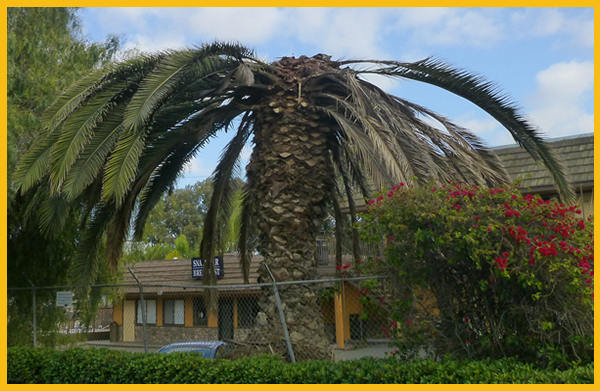What is happening to my Canary Island Date Palm?

Canary Island Date Palm
Question:
What is happening to my Canary Island Date Palm?
Answer:
The brown mushroom looking top on this Canary Island Date Palm (Phoenix canariensis) has sadly become a more common site in the San Diego County landscape due to an invasive pest. The South American Palm Weevil – SAPW (Rhynchophorus palmarum) has spread north to San Diego, from the time it was first collected in 2010 in Tijuana. It is now also in parts of Arizona, Texas and Florida.
Native to Central and South America, parts of Mexico, and the Caribbean, this insect poses an enormous threat to both the ornamental and edible date palm industry in California. The SAPW is known to attack and reproduce on many palm species including Canary Island Date Palm (Phoenix canariensis), the edible Date Palm (Phoenix dactylifera), Coconut Palm (Cocos nucifera) and true Sago Palm (Metroxylon sagu) to name a few.
Adult weevils can fly miles from an infested palm and lay eggs on a new host. The weevil’s larvae feed on tissue in the apical meristem or palm heart which is typically at the top of the trunk in the crown of the palm where the new frond and trunk growth are generated. This kills live fronds and eventually destroys the crown. Adult weevils will also feed on the ripe fruit of some of our favorite non-palm fruits including avocados, citrus and pineapple.
The destructive SAPW is creating a financial hardship for people with Canary Island Date Palms. Infested trees eventually die and it can cost thousands of dollars to safely remove a large, dying or dead palm. Not doing so can risk injury or death when damaged fronds drop from a tree or if the entire crown breaks off. Protecting a healthy palm from SAWP is possible, but costly, and this may be an option for high value trees. A Certified Applicator can spray the palm’s crown and treat the soil with a systemic insecticide to protect the tree. To remain effective trees must be retreated every three to four months for an indefinite period. The effectiveness of chemical treatment rapidly declines after a tree is infested with SAPW but it is difficult to detect SAPW when a palm is initially attacked.
The South American Palm Weevil is also the vector for the pathogen Bursaphelenchus cocophilus, commonly known as red ring nematode (RRN) which is the cause of red ring disease in palms. Palms that are infected with the nematode can show signs of distress and die in only 3-4 months. RRN has not been detected yet in SAPW insects collected in California but it is common for the invasive vector to precede the arrival of the pathogen by several years.
There are 2 things we can do to prevent the spread of this invasive pest and help preserve California’s palms.
- Report any palms that exhibit a brown umbrella look or a partially dead, tilting crown. Scientists at The Center for Invasive Species Research at the University of California, Riverside, are collecting data on the SAPW. You will need the address (including the county) where the tree is located and you have the option to send a photo. https://cisr.ucr.edu/invasive-species/palmarum-survey
- Hire a professional arborist to remove infested, dead or dying palms on your property. This can stop the next generation of weevils from flying to another host on the block or in the canyon. The infested material removed (usually only the top 25% of the tree where the SAPW larvae have been eating away at the apical meristem) should be chipped, then tarped securely and transported to a certified landfill that will bury the material in 24 hours or less.
To learn more about the South American Palm Weevil visit https://cisr.ucr.edu/invasive-species/south-american-palm-weevil
DeLayne Harmon is a member of the UCCE San Diego County Master Gardener Class of 2020. Get free gardening advice on the Master Gardener Hotline, (858) 822-6910, or by email at help@mastergardenersd.org. Due to COVID-19, the Master Gardener Hotline staff members are working remotely to ensure they respond to your questions in a timely manner.

